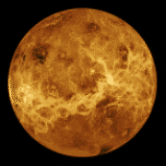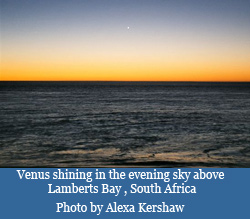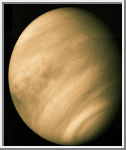Jupiter is the fifth planet from the Sun and is the largest one in the solar system. If Jupiter were hollow, more than one thousand Earths could fit inside. It also contains more matter than all of the other planets combined. It has a mass of 1.9 x 10
27 kg and is 142,800 kilometers (88,736 miles) across the equator. Jupiter possesses 28 known satellites, four of which - Callisto, Europa, Ganymede and Io - were observed by Galileo as long ago as 1610. Another 12 satellites have been recently discovered and given provisional designators until they are officially confirmed and named. There is a ring system, but it is very faint and is totally invisible from the Earth. (The rings were discovered in 1979 by Voyager 1.) The atmosphere is very deep, perhaps comprising the whole planet, and is somewhat like the Sun. It is composed mainly of hydrogen and helium, with small amounts of methane, ammonia, water vapor and other compounds. At great depths within Jupiter, the pressure is so great that the hydrogen atoms are broken up and the electrons are freed so that the resulting atoms consist of bare protons. This produces a state in which the hydrogen becomes metallic.
Colorful latitudinal bands, atmospheric clouds and storms illustrate Jupiter's dynamic weather systems. The cloud patterns change within hours or days. The Great Red Spot is a complex storm moving in a counter-clockwise direction. At the outer edge, material appears to rotate in four to six days; near the center, motions are small and nearly random in direction. An array of other smaller storms and eddies can be found through out the banded clouds.
Auroral emissions, similar to Earth's northern lights, were observed in the polar regions of Jupiter. The auroral emissions appear to be related to material from Io that spirals along magnetic field lines to fall into Jupiter's atmosphere. Cloud-top lightning bolts, similar to superbolts in Earth's high atmosphere, were also observed.
Jupiter's Ring
Unlike Saturn's intricate and complex ring patterns, Jupiter has a simple ring system that is composed of an inner halo, a main ring and a Gossamer ring. To the Voyager spacecraft, the Gossamer ring appeared to be a single ring, but Galileo imagery provided the unexpected discovery that Gossamer is really two rings. One ring is embedded within the other. The rings are very tenuous and are composed of dust particles kicked up as interplanetary meteoroids smash into Jupiter's four small inner moons Metis, Adrastea, Thebe, and Amalthea. Many of the particles are microscopic in size.
The innermost halo ring is toroidal in shape and extends radially from about 92,000 kilometers (57,000 miles) to about 122,500 kilometers (76,000 miles) from Jupiter's center. It is formed as fine particles of dust from the main ring's inner boundary 'bloom' outward as they fall toward the planet. The main and brightest ring extends from the halo boundary out to about 128,940 kilometers (80,000 miles) or just inside the orbit of Adrastea. Close to the orbit of Metis, the main ring's brightness decreases.
The two faint Gossamer rings are fairly uniform in nature. The innermost Amalthea Gossamer ring extends from the orbit of Adrastea out to the orbit of Amalthea at 181,000 kilometers (112,000 miles) from Jupiter's center. The fainter Thebe Gossamer ring extends from Amalthea's orbit out to about Thebe's orbit at 221,000 kilometers (136,000 miles).
Jupiter's rings and moons exist within an intense radiation belt of electrons and ions trapped in the planet's magnetic field. These particles and fields comprise the jovian magnetosphere or magnetic environment, which extends 3 to 7 million kilometers (1.9 to 4.3 million miles) toward the Sun, and stretches in a windsock shape at least as far as Saturn's orbit - a distance of 750 million kilometers (466 million miles).










